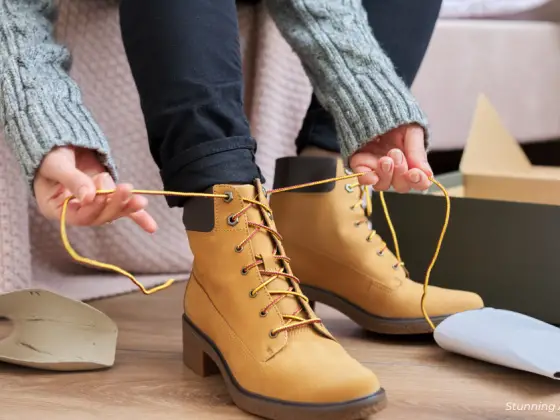 Running is a type of aerobic exercise that is suitable for all ages. Whether you enjoy hiking, trail running, or jogging, it can be done. When you strike your feet to the ground, controlling how your body shocks is impossible. Additionally, you can get joint strains or further injuries if you need a proper foot foundation. Picking the perfect running shoes is the key to preventing it from worsening. It also allows your feet to feel comfortable while exercising. In this guide, I will help you to choose the perfect running shoes for different foot types.
Running is a type of aerobic exercise that is suitable for all ages. Whether you enjoy hiking, trail running, or jogging, it can be done. When you strike your feet to the ground, controlling how your body shocks is impossible. Additionally, you can get joint strains or further injuries if you need a proper foot foundation. Picking the perfect running shoes is the key to preventing it from worsening. It also allows your feet to feel comfortable while exercising. In this guide, I will help you to choose the perfect running shoes for different foot types.
Determine Your Pronation Type
Pronation occurs when your feet land on the ground while sprinting or walking. It is imperative to learn this concept as we have different pronation types. Learning this factor will help you choose a pair with even weight distribution and minimize energy. Specifically, there are three running shoe pronation guides:
Neutral Pronation
Neutral pronation occurs when your foot rolls 15 degrees inward when it hits the ground. The type of inward rolling provides even weight distribution and shock absorption. You are less likely to suffer shock-related injuries since it promotes better balance. However, you can still experience complications, but your risks are lower here.
Overpronation
Overpronation happens when your foot rolls inwards beyond 15 degrees. In other words, it is also known as excessive pronation. It promotes a higher risk of injuries because your foot’s inner or middle edge takes more impact. It is riskier than neutral or normal pronation because you must balance your feet. Compared to the mentioned pronation, it involves shock-related injuries to look forward to. These are shin splints, plantar fasciitis, bony bumps, and heel spurs.
Underpronation
In supination (or underpronation), your foot rolls outward and lands on the outside. It is contrary to overpronation since you roll your foot more outward rather than inward. Like overpronation, it also corresponds to different foot injuries. Some injuries to watch are plantar fasciitis, shin splints, and ankle strain.
Learning your pronation type will help you balance weight distribution and shock absorption. It leads to different ways, and here are the actions you can execute:
- Reach out to specialists. If you are beginning your trailing journey, contacting experts could help. Consult a medical professional or ask the store where you bought your footwear. Feel free to ask them further questions since they can guide you.
- Conduct a gait analysis. You can learn your pronation type by taking a running or wet footprint test. Take note that other methods can be considered depending on your specialists. By doing this analysis, you can receive personalized and better support in selecting the proper footwear.
- Check for wear and tear. You can learn it by checking your overused footwear if you are a pro runner. Although you can get second opinions from experts, they can provide additional information about how you land on your feet. These are things to consider.
-
- Neutral Pronation: If your old footwear has an S-shaped wear pattern, it indicates that your pronation type is neutral. It means that the weight is evenly distributed as you run, with wear primarily occurring at the big toe, the center of the ball of the foot, and the lateral heel area. Neutral pronation allows for a balanced stride, reducing the risk of injury and promoting efficient running form. Runners with this pronation type usually benefit from neutral running shoes with standard cushioning.
- Overpronation: Look for signs of wear concentrated along the inside edge of your shoes, especially near the arch. If you fall into this category, your boots may appear tilted upward when placed on a flat surface, as the excessive inward roll puts extra pressure on the inside of your foot. Overpronation can lead to stress on the knees, ankles, and hips, increasing the risk of injury. Motion control or stability shoes are recommended to help correct this issue and support proper foot alignment.
- Under Pronation: This is the opposite of overpronation, where the foot rolls outward instead of inward. Suppose your shoes are heavily worn along the outside edge, particularly at the lateral heel and pinky toe area, and your foot tilts outward. Underpronation can reduce the foot’s ability to absorb shock, leading to increased pressure on the lower leg and a higher risk of injuries like shin splints. For underpronators, shoes with extra cushioning are essential to provide better shock absorption and comfort.
Learn Different Arch Types or Foot Type For Running Shoes
After learning about the different types of pronation, it’s time to dive into understanding your arch type. Your arch plays a significant role in determining the cushioning and support your running shoes need. These arch types are typically categorized into three, and identifying yours can help reduce discomfort and prevent injuries during exercise:
Neutral Arch
A neutral arch typically causes the foot to roll 15 degrees inward. It allows for even weight distribution across the foot, making it ideal for people with a natural gait. Runners with this arch type usually don’t need much corrective support, but choosing shoes that provide balanced cushioning is essential. Shoes designed for a neutral arch can help absorb shock while maintaining natural foot movement. If your foot has a neutral arch, you’ll likely experience fewer issues with overpronation or underpronation.
Low Arch
A low arch typically forces the foot to bend more than 15 degrees inward. This inward roll, known as overpronation, can stress your ankles, knees, and hips during physical activities. For this reason, shoes with stability or motion control features are recommended to correct excessive pronation. These shoes often come with firm midsoles and arch support to help maintain alignment and reduce injury risk. People with flat feet or low arches may also benefit from custom orthotics for additional support.
High Arch
A high arch means less of your foot touches the ground when walking or running. This lack of contact can cause underpronation or supination, where your foot rolls outward, putting stress on the outer edge of your feet. To counteract this, running shoes with extra cushioning are ideal to absorb shock and provide flexibility. High-arched runners may also experience pressure points or heel pain due to the limited surface area making contact with the ground. Choosing shoes with adequate cushioning and a softer midsole can improve comfort and reduce injury risk for this arch type.
Regarding the arch level, running shoes can also be divided into three categories based on their support level. While these categories aren’t always explicitly labeled on the shoe box, understanding the differences can help you select the proper footwear for your needs.
Neutral Running Shoes
This footwear is ideal for runners who experience mild overpronation supination or neutral gait. Neutral shoes don’t include added support to manipulate foot movement, making them more versatile for a broader range of runners. These shoes provide ample cushioning, which helps shock absorption during running or walking. They offer flexibility, allowing the foot to move naturally, which is particularly beneficial for those without significant gait issues. Although they don’t control motion, neutral running shoes are great for people looking for comfort and protection in their runs.
Motion Control Running Shoes
Motion control running shoes are specifically designed for runners who experience moderate to severe overpronation. This type of shoe features reinforced areas in the arch and heel to help stabilize the foot and prevent excessive inward rolling. As a result, they provide firm support and significantly reduce unwanted motion that could lead to injuries. These shoes tend to be less flexible than other types, focusing more on correcting alignment issues rather than encouraging natural foot movement. Runners who need extra stability and control will benefit significantly from these shoes, as they keep their feet in a neutral position.
Stability Running Shoes
Stability running shoes are designed for runners who experience mild to moderate overpronation. Unlike motion-control shoes, they offer a balance of support and flexibility, helping correct overpronation without restricting natural movement too much. The added support in the midsole or arch area helps keep the foot neutral, reducing the risk of strain or injury. These shoes are an excellent middle ground for runners who need guidance in their foot motion but still want flexibility. Stability shoes are ideal for runners who wish to comfort and corrective support for long distances.
Finding the Perfect Running Shoes
After knowing those tips, you’ll finally buy your new pair. These are the steps to consider before and during visiting your preferred store. It will help you select the best shoes that will fit your feet.
- Choose the largest foot size. Based on statistics, only 1% of the global population has identical foot lengths on both feet. To avoid discomfort, always measure both feet and choose the size that fits the larger one. Buying shoes based on the smaller foot could lead to tightness or pain, especially during longer runs. Ensure the extra room allows your toes to move freely, as a snug fit can cause blisters and other issues. Prioritizing the larger foot ensures that your shoes will be comfortable on both feet.
- Measure it while wearing the running gear you use. When measuring your foot size, it’s essential to wear the gear you plan to use while running. This step includes regular socks, orthotics, or overpronation insoles used during exercise. Wearing these items during measurement ensures the shoes fit when running or walking. Neglecting this step could result in a size that feels perfect in the store but becomes tight or uncomfortable once you wear your running gear. Avoid regrets by making sure everything fits together as you expect.
- Refer back to this blog. Before you head to the store, take a moment to reread this blog from the beginning. Reviewing the guide will remind you of the critical factors to consider when selecting the perfect running shoes, including your arch type, pronation, and the level of support you need. This preparation ensures you enter the store knowing what you’re looking for. Being informed allows you to confidently make the best choice, avoiding being overwhelmed by too many options or sales pressure.
- Test it before buying. One of the most critical steps is thoroughly testing the shoes before purchasing. When you’re in the store, try on different pairs and walk around in them to get a feel for how they fit. Check if the shoes provide the proper arch support for your pronation type and see if they feel comfortable while moving. Don’t hesitate to ask for assistance from the store staff to clarify any doubts or recommendations. Taking the time to test them ensures you won’t be disappointed later when you’re out on a run.
Choosing the perfect running shoes is not just about picking a pair that looks good—it’s about understanding your foot’s specific needs to ensure comfort, support, and injury prevention. Whether you have neutral pronation, overpronation, or underpronation, knowing your foot type is the key to finding shoes that will support your running style. Taking the time to measure your feet, consider your arch type, and test shoes before purchasing will help you avoid discomfort and enhance your running experience. A well-chosen pair of shoes can make all the difference, providing physical comfort and boosting your confidence during every run. Ultimately, the goal is to enjoy your running journey while keeping your feet happy and healthy.















